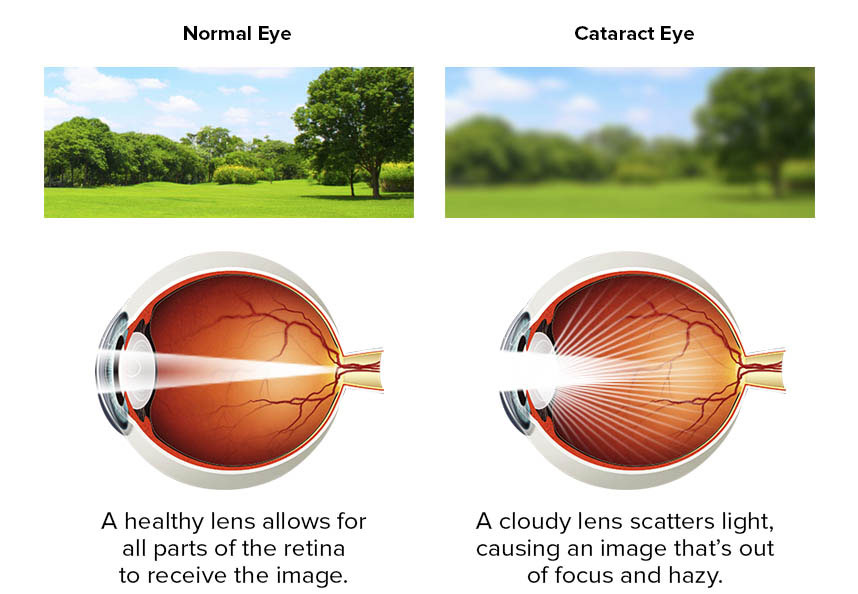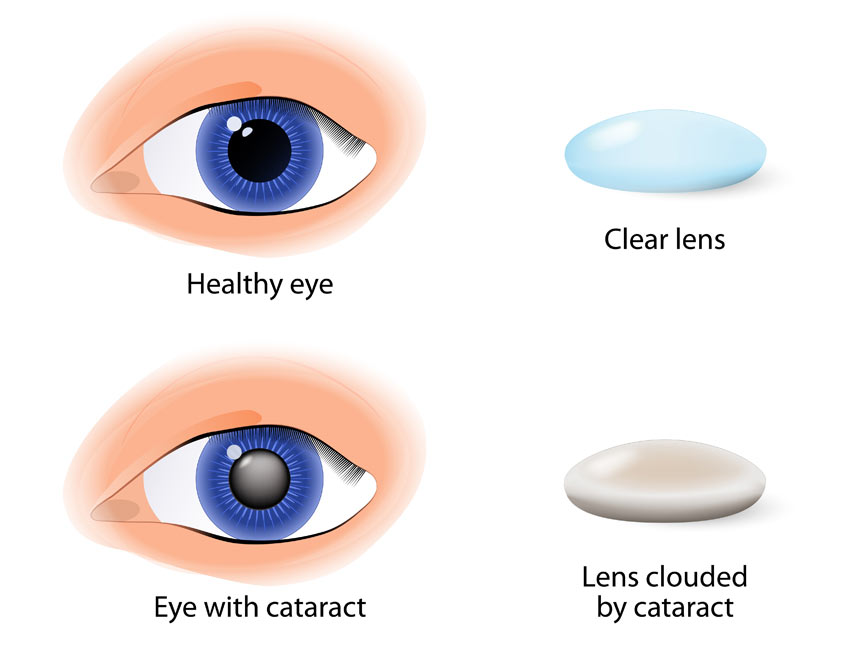Cataract Treatment Surgery (IOL)
What is a cataract?
A cataract is a loss of transparency, or clouding, of the normally clear lens of the eye. As one ages, chemical changes occur in the lens that make it less transparent. The loss of transparency may be so mild vision is hardly affected or so severe that no shapes or movements are seen, only light and dark. When the lens gets cloudy enough to obstruct vision to a significant degree, it is called a cataract. Glasses or contact lenses cannot sharpen your vision if a cataract is present.

The most common cause of cataracts is aging. Other causes include trauma, medications such as steroids, systemic diseases such as diabetes and prolonged exposure to ultraviolet light. Occasionally, babies are born with a cataract.
Reducing the amount of ultraviolet light exposure by wearing a wide-brim hat and sunglasses may reduce your risk for developing a cataract, but once developed there is no cure except to have the cataract surgically removed. The time to have the surgical procedure is when your vision is impaired enough that it interferes with your lifestyle.
Cataract surgery is a very successful operation. One and a half million people have this procedure every year and 95% have a successful result. As with any surgical procedure, complications can occur during or after surgery and some are severe enough to limit vision. But in most cases, vision, as well as quality of life, improves.
Cataract Symptoms
Your eye works a lot like a camera. Light rays focus through your lens on the retina, a layer of light sensitive cells at the back of the eye. Similar to film, the retina allows the image to be "seen" by the brain. Over time the lens can become cloudy and prevent light rays from passing clearly through the lens. This cloudy lens is called a cataract.

The typical symptom of cataract formation is a slow, progressive, and painless decrease in vision. Other changes include: blurring of vision; glare, particularly at night; frequent eyeglass prescription change; a decrease in color intensity; a yellowing of images; and in rare cases, double vision.
Ironically as the lens gets harder, farsighted or hyperopic people experience improved distance vision and are less dependent on glasses. However, nearsighted or myopic people become more nearsighted or myopic, causing distance vision to be worse. Some types of cataracts affect distance vision more than reading vision. Others affect reading vision more than distance vision.
Intraocular Lenses (IOLs)
An intraocular lens (IOL) is a tiny, lightweight, clear plastic disk placed in the eye during cataract surgery. An IOL replaces the focusing power of the eye's natural lens.
The lens of the eye plays an important role in focusing images on the retina. If the lens loses its clarity, as it does when a cataract develops, light rays do not focus clearly and the image one sees is blurry. Glasses or contact lenses cannot sharpen vision if a cataract is present.
The only treatment for a cataract is to remove the lens and implant an IOL. Intraocular lenses have many advantages. Unlike contact lenses, which must be removed, cleaned, and reinserted, the IOL remains in the eye after surgery. Rapid evolution of IOL designs, materials, and implant techniques have made them a safe and practical way to restore normal vision after cataract surgery.
Toric IOLs
Traditional intraocular lenses typically correct distance vision but don’t allow correction for astigmatism or reading vision. We offer specially designed lenses (Toric IOL’s) to correct astigmatism. This can provide significant improvement in uncorrected vision and better visual quality.
Multifocal / Accommodating IOLs
Also available to our patients are Multifocal intraocular lenses which correct both distance and near vision. This decreases, and in many cases eliminates, the need for eyeglasses after surgery.
The Cataract Procedure
The patient is placed in a reclined position and relaxed with an intravenous sedative. Topical numbing drops are administered to the operative eye and a small instrument is placed between the eyelids so the patient does not have to worry about blinking during the procedure. A micro incision is made allowing the surgeon to use delicate ultrasonic technology to gently remove the cloudy cataract from your eye. This process is known as "phacoemulsification". The back portion of the lens capsule is left in place and carefully polished for clarity. The remaining lens capsule supports the small foldable intraocular lens which is inserted through the micro incision. The crystal clear intraocular lens is placed where your cataract was once located to provide you with improved vision. Because the micro incision is self sealing, no sutures are typically needed. Your surgery usually requires 15-20 minutes and there is no patching afterwards. State-of-the-art cataract surgery as provided by The Eye Clinic, Inc. surgeons typically requires no needles, no stitches, and no patches. The procedure is painless and usually patients are back to their normal activities the next day.
